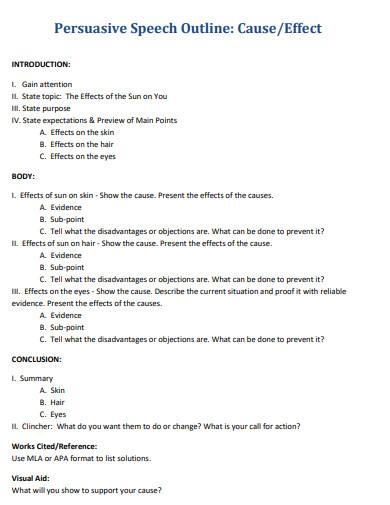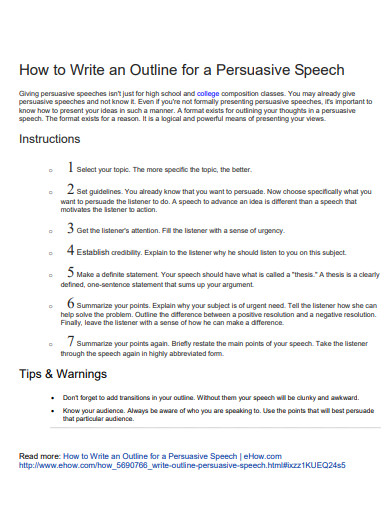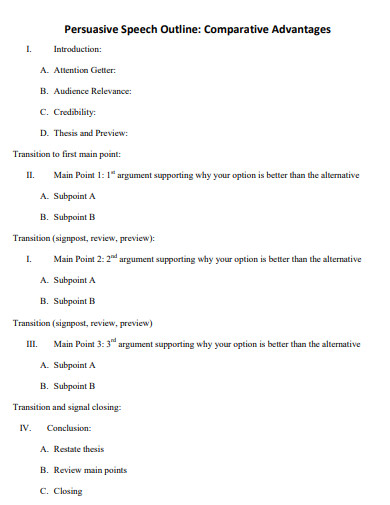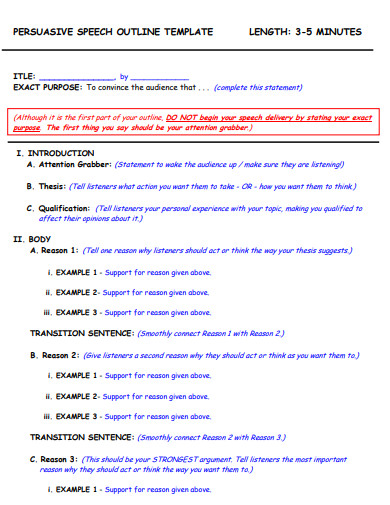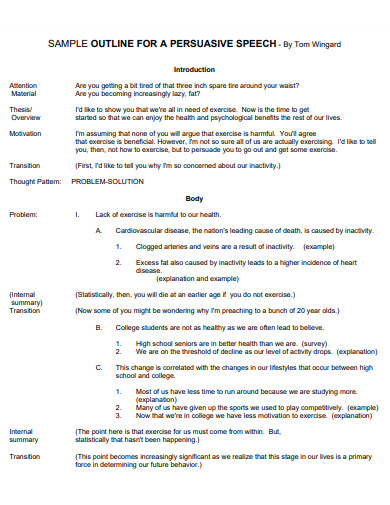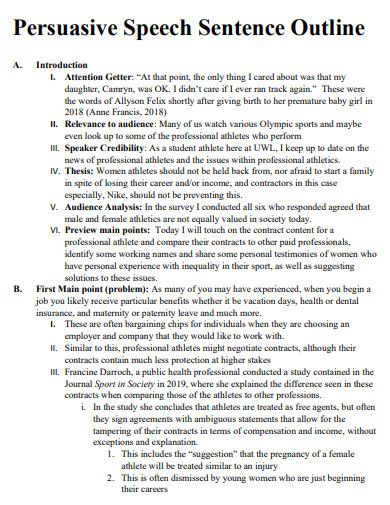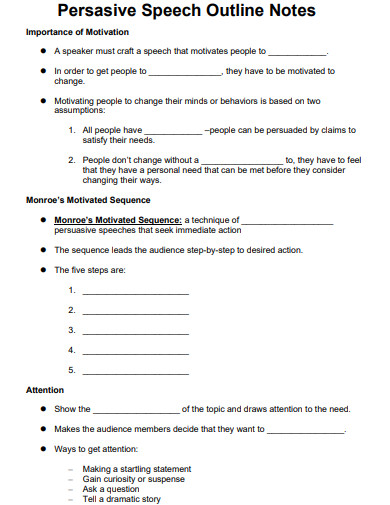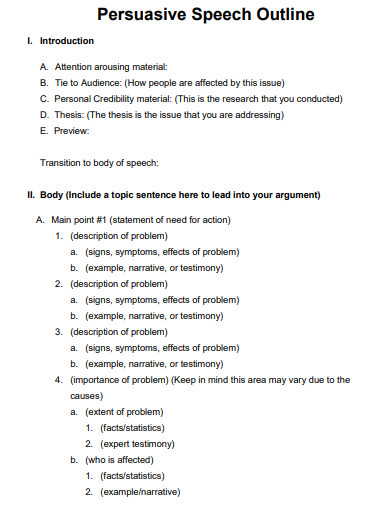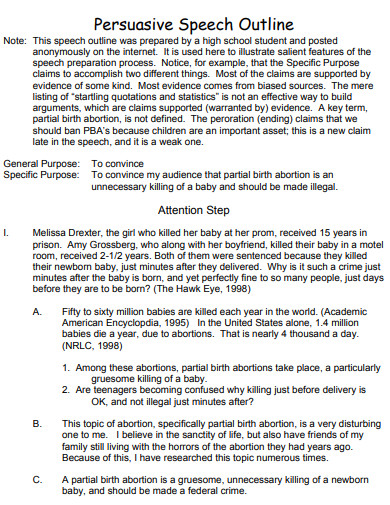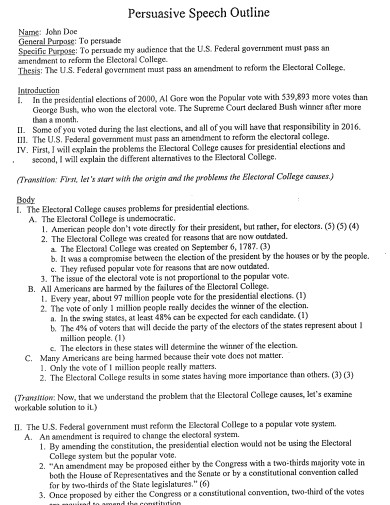Public speaking is a talent that a person obtains through appropriate training and practice as well as dedication to achieve their personal goal of being able to speak in public. An effective speaker should not only know how to speak but should also possess many characteristics such as charisma, humor, charm, and the ability to persuade their audience. There are various types of speeches but the most important and influential of them is the persuasive speech. In this speech, the speaker aims to change the points of view of the audience on a particular topic or subject.
10+ Persuasive Speech Outline Samples
1. Persuasive Speech Outline
2. Persuasive Speech Outline Cause
3. Persuasive Speech Outline Instructions
4. Persuasive Speech Outline Advantages
5. Persuasive Speech Outline Template
6. Sample Persuasive Speech Outline
7. Persuasive Speech Sentence Outline
8. Persuasive Speech Outline Notes
9. Persuasive Speech Outline Example
10. Printable Persuasive Speech Outline
11. Standard Persuasive Speech Outline
What is a Persuasive Speech Outline?
Persuasive speeches are written or delivered in an essay format and presented by a public speaker to convince their audience to acknowledge the viewpoints or ideas they are introducing. This speech can cover a wide range of topics, from arguments about politics to what is the best practice for meal planning. Persuasive speeches establish connections between the speaker and the audience in the sense that the speaker has to keep the audience engaged by meeting them halfway through the discussion.
How to Write a Persuasive Speech Outline?
A persuasive speech outline is a model used for creating a persuasive speech, from the layout planning of the speech to how it should be presented to the audience. Like student papers or research paper essays, a persuasive speech has an introduction, body, and conclusion. Another factor in creating an effective persuasive speech outline is providing the audience with reliable and accurate information about the topic you are presenting, encouraging them to believe your ideas or points of view.
Step 1: Determine the Structure of your Speech
Consider how you will open and close your speech. A strong opening statement can grab the attention of your audience which you can achieve by stating a statistical analysis of facts or including your audience by making them part of your story to establish an emotional connection between your audience and your speech.
Step 2: State your Argument
Consider choosing two to four themes to present in your speech to give you enough time to explain your point of view and persuade your audience to think the same. You also have to make sure that the transitions of your points are seamless while also ensuring its logical flow. Support your argument with objective research and use elements such as examples, stories, and analogies to make your audience relate to your topic.
Step 3: Address Possible Counter-Arguments
Addressing possible disputes or counter-arguments about your topic allows you to strengthen your speech and refute the objections of your audience, which shows them that you are well-informed of their thoughts and opinions on the topic you are covering.
Step 4: Provide a Conclusion
The closing statement of your speech is your last opportunity to persuade your listeners about your thoughts and points of view. It can also be the sentence that your audience will remember the most. An effective persuasive speech ends the presentation with a call-to-action statement.
FAQs
What is the general format commonly used in persuasive speeches?
Persuasive speeches commonly use a general format that starts with an opening statement that grabs the audience’s attention, a thesis statement, the reasons which are statements that support the thesis statement, and the concluding statement or also known as the final appeal.
What is the common way to create a persuasive speech outline?
The most common method to create a persuasive speech outline is by introducing the topic or thesis statement in the introduction, including the reasons and supporting details in the body, and providing call-to-action statements in the conclusion.
What are the tips when delivering a persuasive speech?
Before you present your persuasive speech, it is important to do some practice by recording yourself while speaking and listening to it to determine any unnecessary habits you might have, display confidence through body language, prevent memorizing each word of your speech, use facial expression, and deliver your speech in a concise manner.
A persuasive speech is a type of speech that intends to convince the audience in believing or acknowledging the idea or thought that a public speaker is presenting in his speech. This speech is one of the most commonly used methods in presenting an idea or argument which covers a wide range of topics. Persuasive speech topics are usually thought-provoking in which various people can express their opinion.
Related Posts
FREE 37+ Speech Formats in PDF MS Word
FREE 9+ Salutatorian Speech Samples in PDF
FREE 8+ Sample Tribute Speech in PDF
FREE 10+ Sample Statement of Purpose in PDF MS Word
FREE 44+ Speech Samples in PDF MS Word
FREE 5+ Sample Graduation Speech in PDF
FREE 8+ Persuasive Writing Samples and Templates in PDF
FREE 10+ Demonstrative Speech Outline Samples in PDF DOC
FREE 36+ Introduction Speech Samples in PDF
FREE 10+ Student Commencement Speech Samples [ Graduate ...
FREE 8+ Persuasive Essay Samples in MS Word PDF
FREE 10+ Graduation Speech Templates in PDF MS Word
FREE 10+ Commencement Speech for College Samples in PDF ...
FREE 8+ Informative Speech Samples in MS Word PDF
FREE 12+ Sample Informative Speech in PDF MS Word


